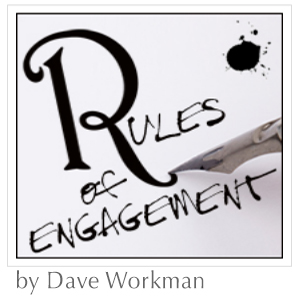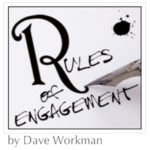.
 A notebook for fiction writers and aspiring novelists. One editor’s perspective.
A notebook for fiction writers and aspiring novelists. One editor’s perspective.
Next post • Previous post • Index
Writing Great Dialogue (Part 4)
Dialogue vs. Monologue
(Also: Revealing info via newspapers, TV,
radio, telephone, social media and texting)
“I love you, Carlotta,” he said.
I love you, Carlotta, he thought.
So…what’s the difference? To Carlotta, probably a great deal. And to the reader as well. To recap a bit, both spoken dialogue and inner monologue* are integral parts of the same revelation delivery system (with the omniscient narrator being the third option—the all-seeing author revealing anything and everything of necessity to the reader).
The key to precise communication with your readers is, of course, knowing when to use what. Dialogue is an information exchange between two or more characters. Monologue is an information exchange between a character and the reader. Omniscient narration, BTW, is an information exchange between the writer and the reader. A quick for-instance:
Dialogue: “I’m not sure you fully understand the danger,” Daniel said, rubbing his chin whiskers. “The road ahead isn’t exactly safe, Mrs. Phelps. Even if we make it, you’re not going to like what we find at the other end.”
Monologue (3rd Person): Daniel absently rubbed his chin. He wasn’t sure Mrs. Phelps understood the dangers ahead. This isn’t going to be easy, he thought to himself. Even if they made it, he wasn’t sure she’d like what she’d find waiting at the other end.
Monologue (1st Person): I’m not sure Mrs. Phelps understood the dangers ahead. I scratched the stubble on my chin, taking time to ponder the consequences. This wasn’t going to be a safe journey for either of us. Even if we made it, I wasn’t sure she’d like what she’d find waiting at the other end. (See more about First Person Dialogue in Dialogue Part 5.)
Omniscient Narrator: The road ahead would be long and arduous. Perhaps even dangerous. The driver rubbed his chin, searching for words. Neither Mrs. Phelps or Daniel McKay would like what they’d find waiting at the other end.
Another option also exists—an overused form of dialogue that I recommend only in snippets:
“We interrupt this program to bring you a special report!” the newsman said, suddenly frantic…
Newspapers, Radio, TV, Telephone, Social Media and Texting.
(Revelation from afar)
If you’re a beginning or uncertain writer, I would strongly suggest avoiding using TV, radio, newspaper ‘talking heads’ to deliver relevant voices. Can TV/news reports prove valid? Absolutely! However, I’m aware of some writers who jump to use this fictive device, hoping for a quick infusion of pertinent info. A line or two may be helpful, but avoid more than a paragraph—and certainly not pages!—of mass media reporting.
Telephone conversations are a bit less distracting, imho—but still, use in moderation. And yet a phone conversations can appear much like face-to-face dialogue:
. . . . .Mary picked up her iPhone, poked out Mark’s number and waited for a breathless moment until she heard his voice “Hey, are you coming over tonight?”
. . . . .“Of course,” he replied. “I’m sorry, but I have to work late tonight. I can’t make it until ten-thirty, or maybe eleven. I hope that’s okay.”
. . . . .“I’ll be waiting,” she said with a smile. (Even on a phone call, it’s okay to show characters’ reactions, even if only for the reader’s benefit.)
I also advice caution, and moderation, when depicting texting, which can easily appear in print in conversational form—although truncated—and can actually work as valid dialogue. I suggest indenting texts and use a san-serif font like Helvetica or Arial, to further differentiate words in text form. I also include the names of those texting. (And don’t use dialogue tags!)
. . . . .Mary: Are you coming over tonight?
. . . . .Mark: I have to work late. Maybe about 10:30 or 11?
. . . . .Mary: I’ll be waiting!
Or even (if you absolutely must):
. . . . .Mary: R U coming over 2nite
. . . . .Mark: workin late. Maybe 10:30 or 11
. . . . .Mary: i can’t w8
Again, don’t include dialogue tags. Ever! Stay away from:
. . . . .Mary: R U coming over Tnite, she asked breathlessly.
. . . . .Mark: workin late. Maybe 10:30 or 11. He hesitated, knowing that he might not finish in time.
. . . . .Mary: i can’t w8!
Instead:
. . . . .Mary: Are you coming over tonight?
. . . . .She paused, her fingers trembling with excitement
. . . . .Mark: I’m working late. Maybe 10:30 or 11.
. . . . .He wasn’t sure he’d finish in time, but he was sure as hell going to try. Screw Marty! he thought. Who cares if the quarterly numbers were a day late?
. . . . .Mary: I’ll be waiting!
Despite the often antiquated inadequacies of traditional prose, realize that readers over 25(ish) may have trouble deciphering some forms of conversation/communication in the age of social media. Shortcuts abound, many to which older readers are not privy. Common grammatical notations—punctuation*, for example—remain a viable necessary for many readers to comprehend. If you’re writing a contemporary story with a cast of Gen Z’ers and you’re comfortable with contemporary teenage slang, your story directed toward a young audience, yes, you have a certain leeway. But again, it’s the writer’s obligation to provide clear and concise information. Know your audience!
*My favorite example of a punctuation snafu:
Let’s eat, grandma!
Let’s eat grandma!
So whatever your intention, don’t lose touch with clarity.
And please, please, please do not include emojis in fiction writing to express emotion to readers. Maybe in 20 years I’ll feel differently… but not yet. Not now. Just don’t.
However, back to mass media in general. As a reader, few gimmicks annoy me more than “a suddenly introduced outside source”—a TV or radio broadcast, a blog or newspaper article—barging into the story, intruding upon a cast of characters that I’ve slowly come to love or hate. OK, so on rare occasions, this gimmick may function as a bona fide tool, and can work successfully.** However, when improperly or indiscriminately placed, using mass media not only screams neophyte to the reader, but tends to send any impending drama or emotion in a scene down the proverbial drain.
Why? Mass media is a particularly sterile delivery system and tends to pull the reader out of the immediacy, the intimacy, of a story. Plotting is largely about questions and answers, after all—Does she love me? What’s behind this locked door? Will we survive charging into this forest filled with armed Lutherans?—and most readers will be repulsed (repulsed, I tell you!) by a lazy writer and the quick, easy cheat of stepping outside of an established story-line to drop a bit of relevant information.
But do be aware that many writers misuse these devices—delivering lengthy, rambling synopses of some plot-specific tidbit. As a reader, deluged with such a vapid delivery, I’ll glaze over after the first paragraph and either quickly peruse or skip the rest. Realize that you’re distancing the reader from both plot-tension and character nuance. So if you feel you must use mass media as a plot device, use it sparingly.
My suggestion is—rather than deliver a 100-200-word TV news report or rambling, lengthy newspaper or news-feed article—truncate the info by allowing your character(s) to becoming involved ASAP. If you’re able, bypass any direct television intrusion (in the example below) all together. For instance, and let’s say we’re writing about a cranky, old, hard-drinking PI, who’s trying to solve a murder mystery. Who killed Henry Patterson?
…..I thumbed the remote, hoping to catch the last half of the Celtics game while I polished off the remnants of a quickly-warming six pack of Rolling Rock. I wanted to wash away the last vestiges of Mrs. Patterson’s troubles, and drinking myself into a stupor was a time-honored option. But the TV blinked on and there was Mrs. Patterson herself—an old photograph anyway—brooding above a Breaking News crawler.
…..I didn’t have to wait for the the details—I knew the signs. The flashing lights, the meandering CSI technicians, the grimacing on-the-spot reporter; I was fairly certain that Mrs. Patterson had joined the ranks of the dearly departed. So much for my theory that the woman had killed Henry for his money. Meaning someone else had killed Mr. Patterson—and had now offed his wife—hoping to get their hands on all those missing millions. Which more or less dropped me back at square one…
So, sure, feel free to insinuate a news source (TV, radio or newspaper) to push your plot forward—but make such an emotionless intrusion relevant to your character, who then makes it relevant to the reader. In this case, my crusty PI takes over and brings the story quickly back into his own POV, where hopefully the reader is quite comfortable by now. Now you can add a few additional plot-points (mascaraing, perhaps, as character-building) as well…
…dropped me back at square one.
…..The helpful TV news-lady droned on. “Mrs. Henry Patterson, 72, had been one of several suspects in her husband’s disappearance and presumed death three months ago. She is survived by her two sons and a step-daughter….”
…..I took another sip of tepid brew and stared at the tube long enough to get the gist. A suspected burglary, gone awry. Always a suspected burglary, and always going every which way but right. Every damn time. The thing is, suspected burglars usually don’t stab their victim multiple times, and the coroner’s office appeared fairly specific in that regard. Multiple times. A pretty pissed-off burglar, if you ask me. And I was pretty sure the police would be asking me, come sunrise. Which gave me an idea….
I offer the same advice for a newspaper story. Instead of concocting a lengthy article (as fun as that may be to create), give the reader the gist and have a character take over at the first opportunity:
…..I shuffled down the porch steps in a faded Red Sox T-shirt and tattered boxers—probably giving old Mrs. Quimbly across the street an eyeful. I was probably the last guy on the block who read the morning paper—but I was also the only guy on the block with two cockatoos, Stan and Ollie, and I’d rather have them pooping on yesterday’s news than my counter tops. I reached down for the paper and immediately saw the glaring headline: Wealthy Heiress Murdered in Brighton. I didn’t need to see more—my gut already told me that Mrs. Patterson was dead, and so much for my theory of who killed her husband, Henry…
Also note that newspaper articles (TV and radio too) don’t rely on detailed or ‘chatty’ information. So if you’re going to use mass-media, study those formats. Don’t try to sneak in clever or intimate clues, because initial reports are typically vague, incomplete and often incorrect. They don’t rely on ‘unsubstantiated reports’ or speculation by friends and neighbors. Just the facts, ma’am. So maintain the integrity of whatever medium you’re using. Otherwise, you’ll lose credibility.
But otherwise, yeah—used with a little discretion, it’s okay to give your readers a glimpse of the daily news.
One last note: Don’t confuse using mass media (as described above) with using character-centric media—for instance somebody reading a passage from a mother’s diary, a series of love letters, even a chatroom exchange—these are all tools that can be used to reveal specific info. Readers tend to be comfortable with characters writing or calling or texting.
– – – – –
* Monologue. Don’t confuse monologue (AKA: inner monologue. AKA: thinking) with soliloquy, a scene where a solitary character speaks thoughts aloud. An insane Lady McBeth’s infamous “Out, out damn spot” for instance. Inner monologue is simply a character’s unspoken thoughts—unknown to other characters, but crystal clear to the reader. If Shakespeare is lost on you, think of Tom Hanks’ longer conversational interactions with a volleyball named Wilson, in Cast Away. Filmmaker Spielberg could have optioned to provide Tom Hanks with a VO (voice over) as well, speaking directly to audiences without ever opening his mouth: Wilson? If you could only talk…” Although, in this instance, I believe dialogue’s the better solution. It reveals the character’s diminishing grip on reality.
** Mass Media. My rule of thumb, when reading/editing manuscripts, is: The shorter the intrusion, the better. A headline, for instance, is OK. A brief snippet of a newscast is OK. So writing 25 words or less is fine. Fifty words is stretching the envelope. One hundred or more words is inviting narcolepsy. A few stanzas of song or poem (for instance, to infuse a specific mood), or a Want Ad (to lure an unsuspecting character to certain doom) can be worthwhile. These are scene-setting or plot-building tools. However, please understand that fabricating an entire 200-word article just to extract a line or two of worthwhile information—well, that’s taboo (…unless you have a very excellent excuse).
.
Next post • Previous post • Index
.
 Dear Friends,
Dear Friends, A notebook for fiction writers and aspiring novelists. One editor’s perspective.
A notebook for fiction writers and aspiring novelists. One editor’s perspective.